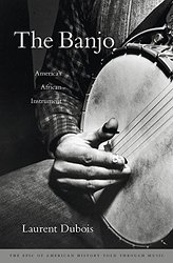Review of Laurent Dubois’s “The Banjo: America’s African Instrument”
 Except
for one thing, this sounds like a great party in 1687, where the
revelers, according to a contemporaneous account, “feast, sing, and
dancce in a confused manner, seeming all mixth men and women
together; thus they howle instead of singing, and play on a kitt
whilst others drum, or beatt against a hollow tree, or board, and the
rest nimbly dance in a strange anticque manner after this their
musick, in such sort that they all seem madd.” The thing that ruins
the reverie, obviously, is that the scene was populated by slaves,
all of whom were but a few years removed (brutally removed) from
their homes in Africa to toil on Jamaican sugar plantations. What
was perceived by the narrator as gaiety, or a crazed frolic, may have
been, at least in part, mourning for their lost country and lost
freedom.
Except
for one thing, this sounds like a great party in 1687, where the
revelers, according to a contemporaneous account, “feast, sing, and
dancce in a confused manner, seeming all mixth men and women
together; thus they howle instead of singing, and play on a kitt
whilst others drum, or beatt against a hollow tree, or board, and the
rest nimbly dance in a strange anticque manner after this their
musick, in such sort that they all seem madd.” The thing that ruins
the reverie, obviously, is that the scene was populated by slaves,
all of whom were but a few years removed (brutally removed) from
their homes in Africa to toil on Jamaican sugar plantations. What
was perceived by the narrator as gaiety, or a crazed frolic, may have
been, at least in part, mourning for their lost country and lost
freedom.
But the scene is pertinent to Laurent Dubois’s marvelous new book, The Banjo: America’s African Instrument. The “kitt” that the slaves were playing on was a gourd, or calabash (as Dubois points out, they’re not the same thing -- in fact they’re different species) with a neck, an animal skin resonator, and a single string – an ur-banjo. The thing went by various names in early written references (bonjoo, banger, banza, bonjour, banshaw), and a bewildering variety of descriptions, to match the bewilderment that white planters (the only ones writing letters at the time) must have felt upon hearing it. Some were disturbed by how much they liked the “rude instrument,” but admitted that “the uninterrupted twang or vibration of its strings, produces a sound as it dies away, that borders on the sublime.”
Dubois’s aim in writing the book was “to gather every shard of evidence” about the banjo, “especially during its earliest periods.” He has succeeded, and very ably so. Beginning with its African origins, he traces the banjo throughout American history, including, inevitably, some powerful and disturbing stories, like that of the “Banjo Table,” on which slave sales were conducted, to banjo accompaniment, while the human merchandise laughed and danced. In this (to us) weird and harrowing scene, Dubois sees the beginnings of the later minstrel show, with its “cycle of imitation and parody and caricature.”
Minstrelsy and blackface allowed the transition of the banjo from a plantation-centered instrument to one central in American music and culture – and also from black hands doing the playing and picking, to white. America’s history of racial relations is endlessly complicated and endlessly fascinating; much of it, as Dubois proves, can be illustrated by this “link between slavery, race, and music.” The link is one of irony upon irony. For example, the minstrel tradition (that is, white men in blackface who learned banjo music from slaves and former slaves) is “one of the few ways we have to access the soundscapes of the plantation and therefore of recovering a crucial piece of African-American musical history.”
And another: in the twentieth century, many came to see the banjo, by then endemic to Appalachia and bluegrass, as primarily a white instrument –“a remarkable, almost surreal, act of historical silencing,” Dubois says. Perhaps this was partly because African-American string band music was rarely recorded – a sonic historical hole which present-day groups such as the Carolina Chocolate Drops seek to backfill.
As much as the book deals with the place of the banjo in American society and culture, Dubois is equally good in explicating technical issues. The use of animal skin as a resonator (instead of wood, as with the standard European guitar), for example, was a matter of climate and geography -- skins that contract in cold weather are difficult to keep attached to a gourd body, and wood is more plentiful in Europe than in Africa.
Another example: the banjo had always been used in jazz – so why did bebop jazz abandon it? Because, Dubois explains, bebop emphasized use of the cymbal. “In terms of timbre,” he says, “cymbals and banjos have a common energy, and putting them together is a kind of ‘musical redundancy.’” A simple, perfect, explanation.
The great value of “The Banjo” is to show how and why this one musical instrument, with its uniquely beautiful “sound of strings humming over skin,” came to permeate the history of our country and our racial relations – and to do so, as Dubois does, with perception, sensitivity, and affection.